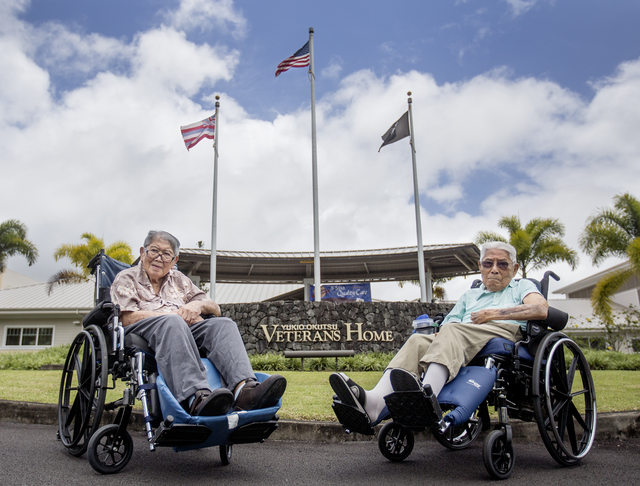Few are left of “The Greatest Generation” retired NBC news anchor Tom Brokaw profiled in his 1998 book, referring to the Americans who grew up during the Great Depression and fought in World War II or contributed to the war effort on the homefront.
Even fewer remain who served in the vaunted 442nd Regimental Combat Team, a U.S. Army infantry regiment comprised almost entirely of American soldiers of Japanese ancestry, who served with valor and distinction, mostly in Europe, during WWII.
The regiment lived up to its motto, “Go for Broke.” In total, about 14,000 men served and earned 9,486 Purple Hearts, eight Presidential Unit Citations and 21 Medals of Honor. That makes it the most decorated unit for its size and length of service in American wartime history. Casualties included 650 killed in action, 3,173 wounded — many more than once — and 67 remain missing in action, according to the U.S. Army Mediterranean Theater of Operations Information-Education Section.
The 442nd was mostly Nisei, second-generation Japanese Americans whose parents were immigrants, and they served at a time when Japanese Americans faced open discrimination at home. The loyalty of many Japanese Americans to the U.S. was openly questioned, and thousands, mostly on the mainland but some in Hawaii, as well, were forced into internment camps, sometimes thousands of miles from their homes. Many also had their homes and businesses confiscated by the government.
The remaining heroes of this remarkable outfit are almost all in their 90s.
William “Bill” Oshiro and Sanford Yanagi are residents of the Yukio Okutsu State Veterans Home in Hilo, named for a 442nd soldier awarded the Medal of Honor for singlehandedly destroying three enemy machine-gun batteries on Mount Belvedere in Italy. Both men served in Italy with the 442nd, Oshiro with 2nd Battalion Co. L, and Yanagi at Regimental Headquarters. Records indicate Oshiro also fought in France.
The 95-year-old Oshiro was a second lieutenant who lost a leg after he stepped on a land mine. The Waipahu, Oahu, native’s awards include the Bronze Star, Purple Heart, Combat Infantryman Badge, Distinguished Unit Badge and European-African-Middle Eastern Campaign Medal.
Oshiro, a retired Department of Veterans Affairs administrator and father of three, is a man of few words, but said he joined the Army “because a lot of people did.”
“I joined the Army to fight the enemy. I feel proud because I fought for the country,” Oshiro said. Reflecting that pride, he served as third president of the 442nd Veterans Club in 1947.
Asked for specific memories of the war, Oshiro stoically pointed to his prosthetic left leg.
Regarding the 442nd’s “Go for Broke” credo, he said, “I felt like we had to because this is our country, and I didn’t know what would happen. I was doing my part.”
The 91-year-old Yanagi is a Holualoa native and Konawaena High School graduate who was drafted in 1942 and was among the 442nd’s first wave of replacements. He wanted to volunteer for service prior to his conscription, “but my mother, like all mothers, didn’t want to see her children go overseas to fight.”
Trained as an infantryman, Yanagi was proficient with his .30-caliber M1 carbine rifle, first achieving sharpshooter status and then expert, the highest military classification for marksmanship, but the Army had other plans for him.
“I didn’t see combat,” Yanagi said, ruefully. “They said they put me where I was needed. I was fortunate.”
Instead, he became a clerk-typist at Regimental Headquarters, in the war zone but not on the front lines.
“He could type really fast, and he knew the Japanese names,” Yanagi’s son, Gary, explained.
The elder Yanagi’s heritage is half-Japanese and a quarter each Chinese and Hawaiian, and he experienced a great deal of discrimination. Questioned about it, tears welled in his eyes and he clenched his right fist, overcome with emotion and unable to speak.
“There are a lot of hidden feelings that come out,” Gary Yanagi said. “When I was growing up, he didn’t talk about the war. He started to talk about it a little more later on. He also has this guilt that some of his friends passed away but he didn’t go into combat with the group.”
Cpl. Yanagi later became a second lieutenant in the Army Reserve and National Guard, but turned down an officer’s commission during the war.
“They wanted to give me a commission, but I wanted to earn it,” he said.
With a sharp mind for administration and a good grasp of numbers, Sanford Yanagi went to work for Amfac, one of Hawaii’s “Big Five” corporations, and became a public accountant and district administrator for the Department of Taxation. He also fathered three sons, Gary, Randall and Tracy. His wife, Frances, died 12 years ago.
“I think she was his strength,” Gary Yanagi said.
Sanford Yanagi also earned the European-African-Middle Eastern Campaign Medal and the Asiatic-Pacific Services Medal. He, Oshiro, and all who served honorably during WWII in the 442nd and the 100th Infantry Battalion were awarded the Congressional Gold Medal in 2010.
”They were on an open bus that went through Waikiki in a parade. He didn’t want to do it, but they earned it,” Gary Yanagi said.
The elder Yanagi thinks many younger Americans “don’t realize how lucky they are.”
With a smile on his face and tears in his eyes, Sanford Yanagi said, “I’m proud to be an American.”
Email John Burnett at jburnett@hawaiitribune-herald.com.






